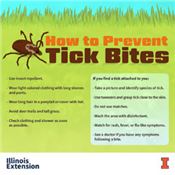Small Big, Big Risk: Protect Yourself From Ticks This Summer

URBANA, ILL.
When venturing in the woods this summer, don’t forget to protect yourself from a small, but dangerous creature likely lurking in trees, grass, and bushes.
Ticks are easy to pick up when visiting grassy areas, woods, prairies, wetlands, deer trails, and brushy areas. These tiny insects can pose a big risk. Ticks are known to spread serious illnesses, such as Lyme disease and Rocky Mountain fever.
Protect yourself from ticks
Although it is important to be safe, ticks should not keep anyone from their usual summer activities. University of Illinois Extension Horticulture Educator Kelly Allsup offers these tips.
Choose appropriate clothing from head to toe. Master Naturalists Shaun Bill says he never goes in the woods without a hat. Other recommended clothing items include a long-sleeved shirt layered over a tight undershirt and long pants with a belt. Wear boots and tuck your pant legs into them to close up any loose openings where a tick might crawl in. Wear light-colored clothing that makes it easier to spot ticks.
Select an insect repellant that is effective against ticks and apply it to all exposed skin. Pest management experts recommend one that contains DEET or picaridin. There are several insect repellent options.
Master Naturalist Vickie Hansen says you can buy clothing that is pre- treated with insect repellant or treat your own clothing.
If you have long hair, wear it in a braided ponytail, when possible.
Allsup also uses a tea tree oil shampoo, which works as another insect repellent.
“I find most ticks in my hair,” says Cassandra Allsup, assistant researcher at the University of Wisconsin. “During the active season, I put lotion in my braid that helps prevent ticks from grabbing pieces of hair when I bend over into vegetation.”
Safety tips
Even with the best preventative measures in place, it’s important to follow some safety tips after returning from outdoor activities.
Allsup recommends thoroughly checking clothing and body after going into forested or grassy areas.
“At the end of a field day, I always do my Mr. Rogers montage: take off my boots, top shirt, and hat and change into flip flops,” she says. "Brush out your hair and remove your outer layer of clothing before getting into your car."
Check carefully for seed ticks. The small larvae are the size of a pinhead. Wash with soap and water and remove any imbedded ticks with tweezers.
"Remember that high heat, not water, kills ticks on your clothing, so dry the clothes for a longer period at high heat," Allsup says.
Removing ticks
Remove ticks in the first 24 to 36 hours to prevent disease transmission. Before removing, take a picture of the tick to identify the type of tick and research what pathogens that species may carry.
Use tweezers or a piece of cloth to grasp it close to the skin. Avoid using matches.
After removing the tick, wash the area with disinfectant. Follow up with a physician if symptoms of a tickborne disease occur at any point during the month following a tick bite. Serious symptoms include a rash or unexplained fever with flu-like symptoms (without a cough).
University of Illinois has an I-tick community science surveillance program to gather information about ticks of public health concern in Illinois.
“The purpose is to develop a network of volunteers to collect data to help university researchers determine the risk of tickborne disease based on where and when ticks occur,” says Allsup. The app allows people to submit tick occurrences and photos by phone.
"The whole process should take less than five minutes," Allsup says.
“It’s fun and easy science anyone can do while contributing to Illinois research.” ∆